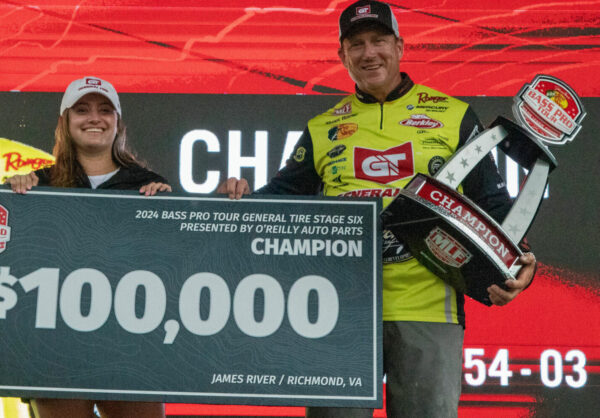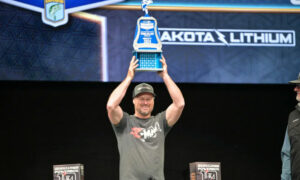Skeet’s won a bunch – including a Classic on a river – and he grew up fishing the Cali Delta, so he knows tidal rivers and he knows how to win. Plus electronics weren’t much of a factor in this tournament so the shallow-water experts – including Skeet – showed out. Here’s how it went down.
Going in and practice
> “The first time I fished there [the James] was that World Championship Fishing event 24 years ago where we did the boat racing and all that. I don’t remember anything about it….
> “The most modern information I had…was I fished [an MLF] Pro Circuit there 2 years ago. That gave me a little bit of insight about how the river lays out and what type of habitat there is.
> “For me it was about tide study more than anything…where to get the best bite at the best time, the best section of the river.
> “I was really on my phone – on the Lowrance app [doing] a lot of map study. Where is the best place to start and where am I going to go as the day progresses.
> “I built a plan. I would up at the lower end of the river…the Chickahominy, and the further you went down, the better the tide was – at the beginning of the week. Later in the day, upriver you had better tide. There’s a 2.5-hr difference form the lower to the upper [in tide].”
About fishing tides
> “Every 6 hours we have a tide – it comes in or goes out…. Depending on where you’re at, the tide might be 6” or some places it’s 10′. The James River had about a 2′ tide.
> “As the tide moves in the, fish move up with the water – and as the tide goes out, it pulls them out. In the morning…all kinds of shoreline [grass], those fish will get up in that stuff and feed. As the tide drops, that is completely out of the water in the mud.
> “…these fish will travel quite a bit. I learned that on the Delaware River. They have a 9′ tide there and you see how far these fish travel – hundreds of yards. They still feed as the tide comes out, it just repositions the fish.
> “The bottom of the outgoing tide and the switch of the incoming – that first 45 minutes of the switch – was money for sure [at the James]. But definitely, the lower the tide got – the end of a laydown, a dock, a cypress tree…it just pulled them out. At high tide they get up and swim on everything. Low tide consolidates them a lot more.”
Practice bites
> “In practice I was getting 40-50 bites a day, but a lot of non-scoreables. …my best bite was flipping a 4” Berkley Power Hog in gp – that’s my go-to tidal river bait. That’s what won the Potomac River on [2007 Bassmaster Elite]. It’s kind of a staple for me.
> “It was easy. Wherever the tide was positioned right and the current…a piling or a tree, it didn’t matter. It was easy to get bites. [He mixed in] a little bit of a crankbait, spinnerbait, bladed jig.
> “The 2nd day of practice was a little bit of a mixed bag. I had a buzzbait bite going, a bladed jig and flipping. [He said he didn’t remember the 3rd day of practice, but started the tournament fishing the same way.]
Tournament
> “The first day of the tournament I flipped only a couple, maybe 3 scoreables. Then the rest were between a BDS1 [Lucky Craft squarebill crank] and a bladed jig. I noticed the BDS1 got better bites and I also noticed Iw as having fish miss the bladed jig. I’d rather have a bait in there with 6 hooks on it rather than 1….
> “By day 3 of the tournament I realized that the BDS1 was my go-to bait. Almost every fish on day 3 and day 4 came on it.
> “…not a fast retrieve, a farily slow retrieve. It’s a little wide-wobble bait. You don’t need to burn it. It’s got a lot of cation and and the fish were not wanting to chase really fast. …I could fish it in 6 inches of water with my rod tip up, and if I needed to get it down a little bit deeper rod tip down [with longer casts] you could it down a couple feet.
> “…just to make sure you get as close to the cover as possible. If the fish were on cypress trees and you cast a foot away from a tree, you did not get a bite. You had to cast within 6 inches of the actual bas of the tree. Your bait hits the water, one turn and they’re on it.
> “…making sure you’re coming by every piling, making sure the bait’s coming downstream as much pas possible, as natural as possible.
> “It was junk-fishing at first, then it evolved into day 3 and day 4…pretty much all docks and bridges.
> “The first 2 days I started in the Chick, but then I would end up 30 miles back upriver. I was chasing the tide up…. Day 3 and day 4 I abandoned the Chick and just focused on the James, just worked the upper section. Went down maybe 15 miles from Appomattox…inbetween the Appomattox and the Chick.”
Main bait
> Lucky Craft BDS1 squarebill (chartreuse shad), 15-lb Berkley Trilene 100% Fluorocarbon, KastKing MG12 Reel (“it’s a smaller profile, almost a BFS reel”), 7′ M glass Reese Fishing Dive Rod.

> He upsized the hooks to #2s: “I don’t ever like having a treble hook that is narrower than the body of the bait. Just for the fact that…if a fish’s jaws hit on the side of the bait, then they can’t get hooked. So I try to have my hooks wider than the body of the bait if possible.”
Electronics
> “Just mapping. My biggest friend was the Lowrance app on my phone because it has tide charts.”
Shoutouts
> “I did abuse the heck out of that Power-Pole Move [troller] this week. I chewed up more mud and shell beds. …when the tide was out, I could move faster on the Move than I could idling to get across mud flats. Idling…you might get 2 mph…even with the jackplate up. I was getting 3 mph [with the move] even with 3 guys in the boat.”




























